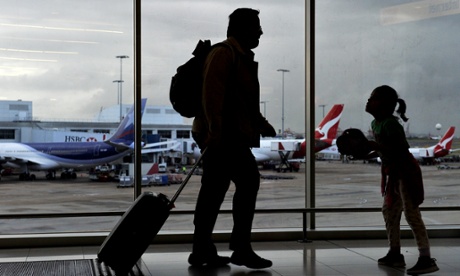
Australians’ consumer confidence may be down, but thus far our love of travelling overseas continues to grow. Held up by the high dollar, Australians continue to holiday overseas. The falling confidence may however be having an impact. The growth of Australians going overseas is lower now than it has been at any time since the GFC.
The growth of Australians holidaying overseas certainly has come off the boil from the heady days of 2010-2011, when the dollar was worth up to $US1.09 and the annual number of Australians going overseas grew by between 10%-20%.
Indeed for the first time this century, the number of international tourists coming to Australia is growing faster than is the number of Australians leaving these shores:
But while the boom of Australians heading OS appears to be peaking, each month there are still many more people leaving our shores for a holiday than foreigners are arriving, and the ratio is as high as it has been for 30 years:
In terms of international tourism, because more Australians are going overseas than international visitors are arriving, we are a net importer of tourism.
This sounds a bit confusing, but it is because when you go overseas you are in effect sending money overseas (ie importing) just like you would be were you to buy products from overseas and actually import them to Australia.
The Australian Bureau of Statistics doesn’t count how much Australian tourists spend each month when they travel overseas, so we can’t say exactly how much of a tourism importer we are in dollar terms. But given there are about 1.3 departures for every arrival, unless foreigners outspend Australians by that much, then more money is going out than coming in.
The reason more people are leaving Australia than are arriving is not due to the drop of foreign tourists, but due to the now 10 years surge of Australians heading abroad:
It’s easy to understand why this has happened when we look at the value of our dollar:
At the end of 2003, our dollar rose to around US$0.75 – a value not seen since 1997, so not surprisingly Australians thought it was a good time to head overseas. Since then, aside from a blip during 2008-09 due to the GFC, the value of the dollar has remained well above average.
So even with the recent fall from over parity with the US dollar, we’re still very much in unusual waters.
But while our appetite for travelling overseas has grown, where we travel has changed over the years. We have become slightly less predictable. In 1991 the top five destinations of New Zealand, United States, UK, Indonesian and Hong Kong constituted 55% of all overseas travel. Now the top destinations (the same as in 1991 except Thailand has replaced Hong Kong) account for 48%.
The big growth destinations have been India, China and Vietnam. In 1992 just 2.2% of overseas travel was to those nations; in the past year it was 10%:
The change in our travel habits becomes more apparent when we look at areas rather than specific countries. Over the past 20 years travelling to New Zealand, Fiji and other areas of Oceania have become less popular. It still remains our most common destination, but whereas in 1991 25% of travel was to those countries, now it is 20%.
Other areas to become less popular are north-west Europe, which has fallen from 16% to 10.8% of travel, and North America. In 1991, 16% of Australians’ travel was to the USA or Canada, now it is 12%.
But the big growth area overall is south-east Asia. It has gone from comprising 22% of travel to now just over 31%.
Even within these areas change has occurred. In 1991, the UK accounted for two-thirds of travel to north-west Europe, now it is just 56%, whereas both Ireland and France have become more common.
And similarly in 1991, nearly 60% of those travelling to south-east Asia were headed to either Indonesia or Singapore. Since then, Indonesia has retained its popularity, but Vietnam and Thailand have risen at the expense of Singapore.
Where we travel is clearly influenced by safety. The percentage of Australians venturing to Indonesia (or Bali, really) has been high for decades (Redgum wrote “I’ve Been to Bali Too” in 1984). But its popularity has taken a number of dips – first due to the political upheaval in 1998-99, then the Bali bombings first in October 2002 and then in 2005:
It has recovered to now be as popular a destination for Australians as it ever was. Whether Egypt will recover from the turbulence there since the Arab spring in 2010 remains to be seen. As yet, Australians are less likely to go there than they have ever been:
But I must admit at this point that looking at overseas travel data always gives me pangs of envy. While friends and family of mine have been among this surge of Australians venturing abroad to reap the benefits of the high Australian dollar, the last time I went overseas was to the United States in July 2001, when the dollar was worth 50 US cents!
But never fear, holidaying in Australia remains a joy, and perhaps something we should all do more of.
Since 2000, and the Sydney Olympics, the importance of tourism in the economy has steadily declined. It is perhaps the industry most affected by the high dollar. And given just under 5% of all Australian workers are employed in tourism, it’s an industry where our travel choice has a direct impact.
It would be ironic if falling consumer confidence causes more Australians to holiday at home rather than abroad, and thus actually help the economy.

